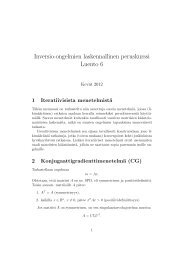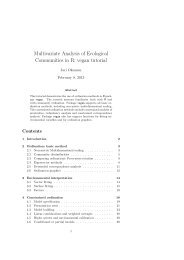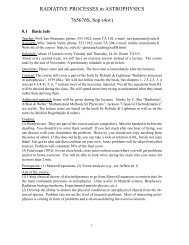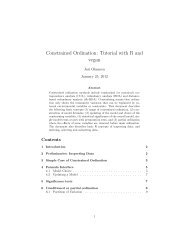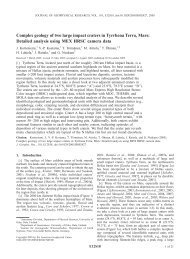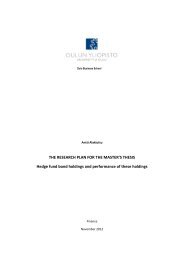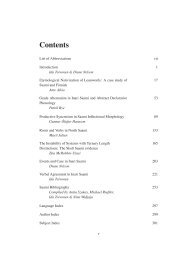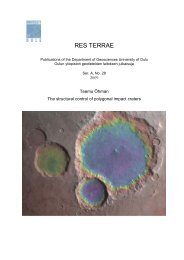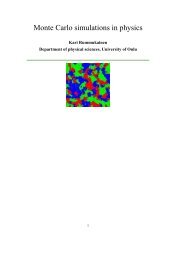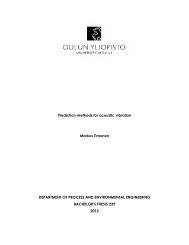Juha Köykkä - Oulu
Juha Köykkä - Oulu
Juha Köykkä - Oulu
- TAGS
- juha
- oulu
- cc.oulu.fi
You also want an ePaper? Increase the reach of your titles
YUMPU automatically turns print PDFs into web optimized ePapers that Google loves.
Res Terrae, Ser. A 32, J. <strong>Köykkä</strong>, Sedimentology of the Mesoproterozoic Telemark basin-fills, South Norway: implications for<br />
sedimentation processes, depositional environments and tectonic evolution<br />
of the Brattefjell Formation, at 1.347 Ga (Corfu and Laajoki, 2008). This gives the sedi-<br />
mentation age for the Vindeggen Group. This group contains the Heddersvatnet, Gausta,<br />
Bondal, Lauvhovd, Skottsfjell, Vindsjå and Brattefjell formations (Figs. 3, 4). The group<br />
begins with a ca. 400-m-thick alluvial fan and associated braidplain Heddersvatnet Forma-<br />
tion, which is deposited directly above an unconformity (sub-Heddersvatnet unconformity<br />
in Fig. 4). The Heddersvatnet Formation consists mainly of massive debris flow conglome-<br />
rates and trough cross-bedded arkosic sandstone with mudstone and basaltic lava interbeds.<br />
The sedimentation patterns, tectonic setting, and geochemistry of the Heddersvatnet For-<br />
mation sandstones, mudstones and basaltic lavas are studied in Papers I and II.<br />
The Heddersvatnet Formation grades into the ca. 750-m-thick Gausta Formation.<br />
Sedimentary facies and structures indicate that the transition corresponds to an evolu-<br />
tion from alluvial to marine depositional environment (Fig. 4). The lower part of the<br />
Gausta Formation is comprised of mostly tabular low-angle cross-bedded quartz sandstone<br />
free of epiclastic volcanic detritus and of locally conglomeratic units with pebble-sized<br />
clasts. The clasts are composed of felsic volcanics and quartzites. The sandstone units are<br />
overlain by wave ripple-marked and tabular cross-bedded sandstone beds. The termination<br />
of volcanism and the deposition of conglomerates with extrabasinal clasts in the lower part<br />
of the Gausta Formation indicate a major change in the rift basin evolution. The Gausta<br />
Formation is overlain by mudstones of the Bondal and Lauvhovd formations (Fig. 4). The<br />
contacts are unexposed. The ca. 250-m-thick Bondal Formation contains mostly heterolith-<br />
ic mudstone-sandstone successions. The mudstones of the ca. 350-m-thick Lauvhovd For-<br />
mation are calcite-bearing. Both formations are mainly characterized by heterolithic, thinly<br />
bedded sandstones and siltstones with wave ripplemarks and cross-bedding with mud-<br />
drapes. These sedimentary structures and facies assemblages suggest a tidal depositional<br />
environment. The Lauvhovd Formation is overlain by the ca. 1-km-thick Skottsfjell For-<br />
mation (Fig. 4). The Skottsfjell Formation is composed of fluvial conglomerates in its low-<br />
er part that are overlain by thick trough cross-bedded arkosic sandstone beds with interbeds<br />
of mudstone. The conglomerates are mainly quartzites and siltstones. Based on sedimenta-<br />
ry structures and facies associations, the Skottsfjell Formation is understood to represent a<br />
braided-type fluvial depositional environment. The Skottsfjell Formation passes into the<br />
ca. 500-m-thick Vindsjå Formation. The contact is again unexposed. The Vindsjå Forma-<br />
tion is characterized by heterolithic and thinly bedded sandstone, siltstone and mudstone<br />
32



